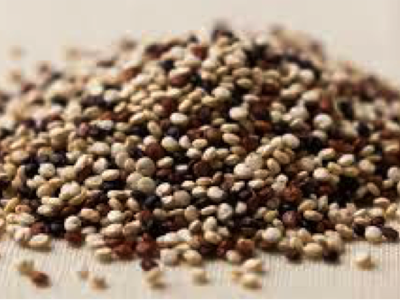Quinoa (Chenopodium quinoa, pronounced Kee-nwah) is a member of the Amaranthaceae family (with Amaranth) and is closely related to beetroots, spinach and tumbleweeds. It is a grain crop, from which humans eat its edible seeds.
Being a member of the Amaranthaceae family and not the True Grass family makes Quinoa a pseudocereal rather than a true cereal.
Quinoa’s first links are with the Andean people in South America 3000-4000 years ago where it was worshipped by the Incas1. It is an indigenous crop to the area but relatively unseen in the rest of the world.
Nutritional Benefits
The protein content of Quinoa is often what is most talked about when it comes to Quinoa’s nutrients. And yes, it does have a decent amount, however, it’s not the amount of protein that makes Quinoa so attractive, rather TYPE of protein. Quinoa has the perfect balance of all nine amino acids essential for human nutrition2,3. This type of complete protein is rarely found in plant foods, though common in meats. This is great news for vegetarians!
Also great news for people with Coeliac Disease, Quinoa is Gluten-free. Plus it has a low Glycaemic index which helps you feel fuller longer and releases the energy slowly into your body, avoiding nasty blood sugar highs and lows.
1 cup of cooked quinoa offers ~8g complete protein4 and 39g carbohydrates4. Quinoa also offers a good dose of fiber, iron, phosphorous and calcium3,4.
There are 3 colours of Quinoa (similar to rice); white, red and black. There is no significant difference in the nutritional benefit between the three types. Red and Black take a bit longer to cook and the cooked seeds tend to stick together less than white quinoa. All have a lovely nutty flavour. It will come down to your personal preference, and availability in your area.
Cooking Quinoa
The naturally grown seeds have a bitter-tasting and mildly toxic coating of saponins5. This occurs naturally and has beneficial effects for the plant, warding off birds therefore providing protection for the species.
To remove the saponins before eating, it’s best to soak your quinoa in water for 1-2 hours and rinse before cooking. If you don’t have time, make sure you rinse the seeds thoroughly as a minimum.
The most common way to cook Quinoa is the absorption method, like you would rice. You can do this in a pot on the stove-top or in the microwave. For every Cup of Quinoa seeds, you’ll need 2 cups of water.
Try having it through your salads or as a porridge (cook like oats with some nut milk mixed with water). Also try using it wherever you might have normally used rice – with curries, in sushi rolls, fried rice! The possibilities are endless!
Other Ways to have Quinoa

You can also buy ‘Puffed Quinoa’ at most healthfood stores and in the healthfood section of the supermarket. This is like puffed rice and is great for a gluten-free cereal or for extra crunch in salads.
Quinoa Flakes are also available which I use whenever I would have previously used oats (think porridge, pancakes, anzac biscuits). Sometimes I’ll blitz the flakes in my blender to make a flour which I then use to bake with.
There’ll be plenty of great Quinoa recipes coming soon to PB Lifestyles recipe section, sign-up for weekly updates to make sure you don’t miss out!
- Keppel, Stephen (March 4, 2012). “The Quinoa Boom Is a Lesson in the Global Economy”. ABC Univision. Viewed 22 Feb 2015
- “Biopesticides Registration Action Document: Saponins of Chenopodium quinoa” (PDF). EPA. 2009.
- “Mother Grain Quinoa A Complete Protein”. Ohio State University, Oardc.osu.edu. Retrieved 22 Feb. 15
- “Quinoa”, Johnson D L, Ward S M., 1993 p219-221 In: J. Janick and J.E. Simon (eds.), New crops. Wiley, New York.
- Nutritional Facts and Analysis of Quinoa, cooked. Retrieved 22 Feb. 15

